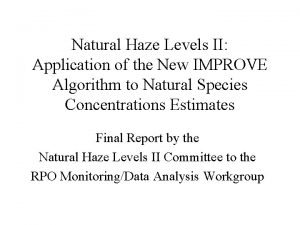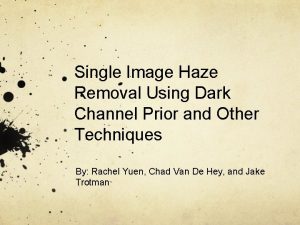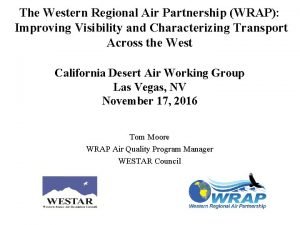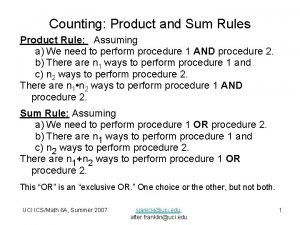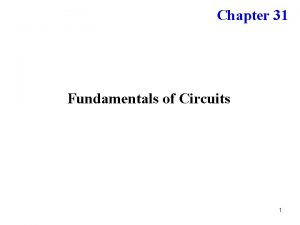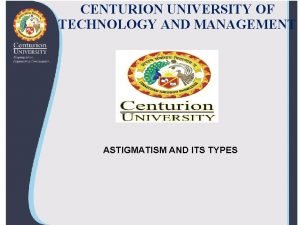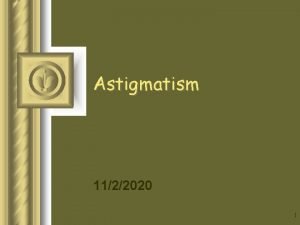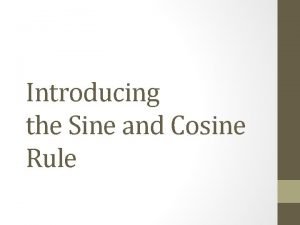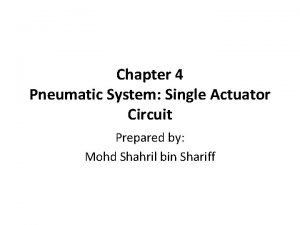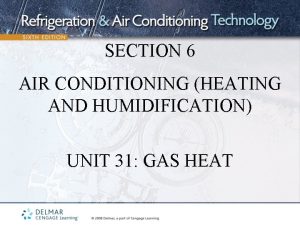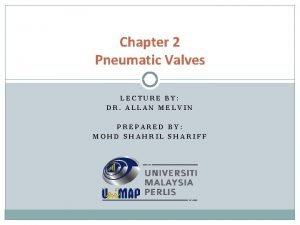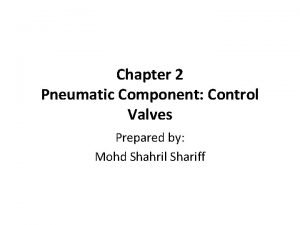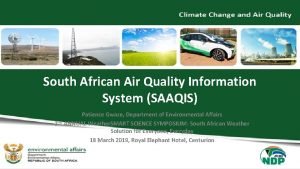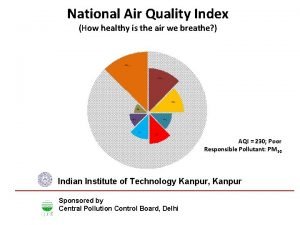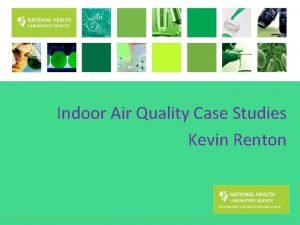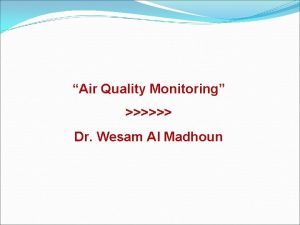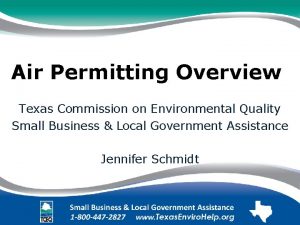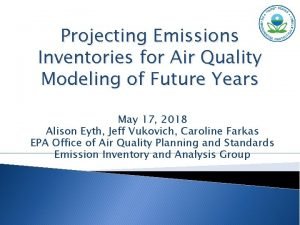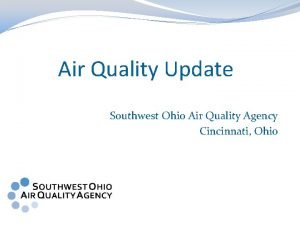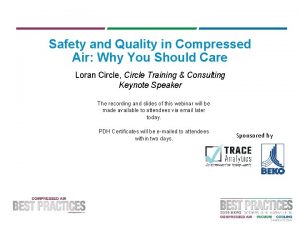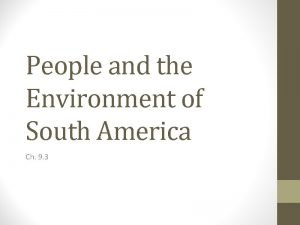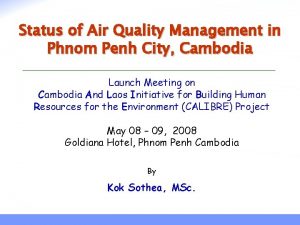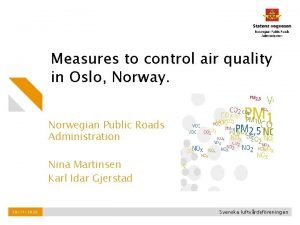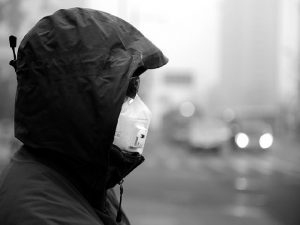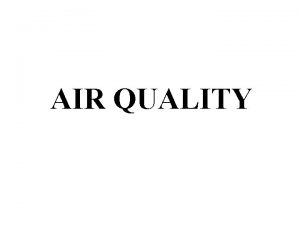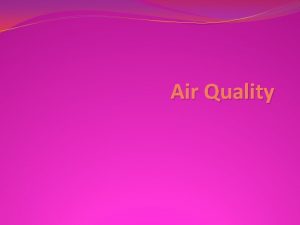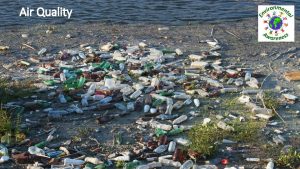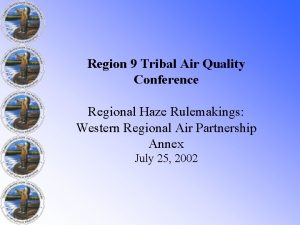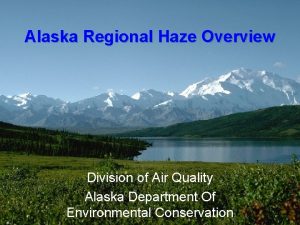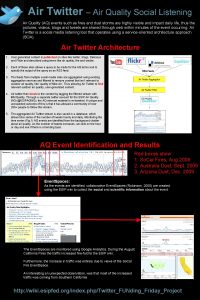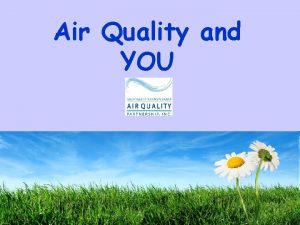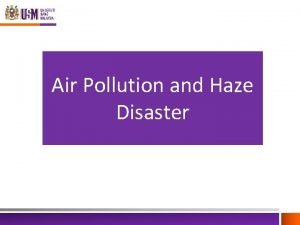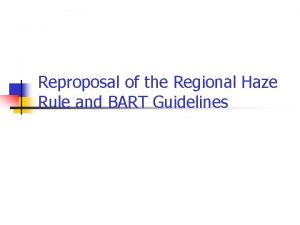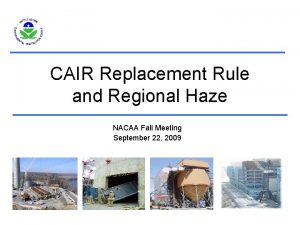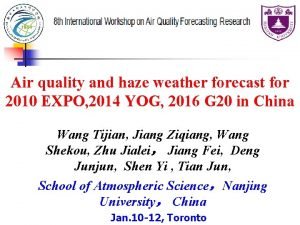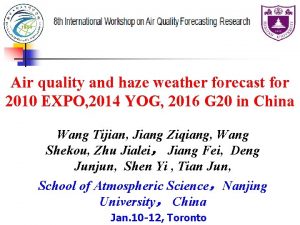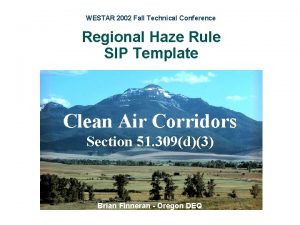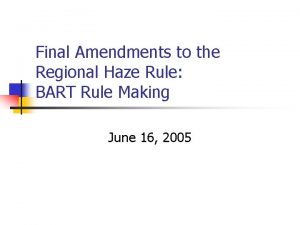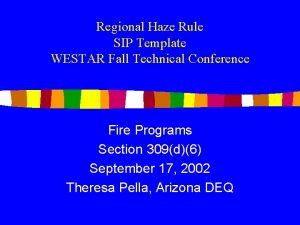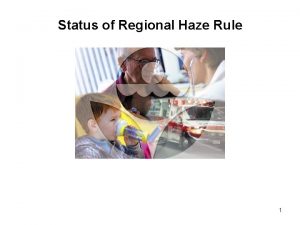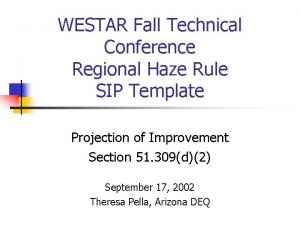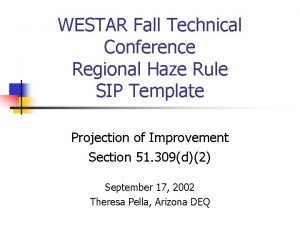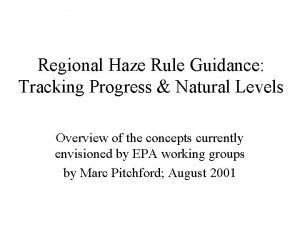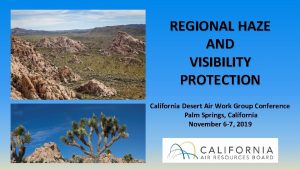Regional Air Quality and the Regional Haze Rule






















































- Slides: 54

Regional Air Quality and the Regional Haze Rule Information and resources for Tribal professionals

Tom Moore WRAP Air Quality Program Manager

Air quality and visibility basics • Clean, clear air is important to people from all cultures, worldwide • It is an important component of the sacred places in many cultural traditions • We appreciate the health benefits of breathing clean air • We also enjoy sweeping views in places with clear air, where we can “see for miles” • Polluted air is not only unhealthy to breathe, but can decrease visibility, making it difficult to engage in traditional cultural practices and diminishing those sweeping views

Visibility in the Clean Air Act • Main federal legislation to control air pollution • Controls a wide range of air pollutants from stationary and mobile sources • Primary focus on human and environmental health • Visibility also important • National Visibility Goal: “…the prevention of any future, and the remedying of any existing, impairment of visibility in mandatory class I Federal areas which impairment results from manmade air pollution” 1 1 Section 169 A of the Clean Air Act, 1977 amendments

Regional haze • Certain types of air pollution form haze, which interacts with light and diminishes the quality of views across distance • Pollution that causes it often comes from far away: thus it is a regional problem • Can interfere with cultural practices for Tribal members, and impair enjoyment of special places, such as National Parks and Wilderness Areas

Additional concerns with regional haze • Also a sensitive indicator of other air quality problems • Same pollutants that cause haze can cause environmental and human health problems: • acidification of lakes and streams • depletion of soil nutrients • damage to culturally important plants, as well as sensitive forests and farm crops • aggravated asthma • respiratory problems such as irritation of the airways, coughing, or difficulty breathing • heart attacks • premature death in people with heart or lung disease

Environmental and health problems associated with haze

Processes that form haze

How haze impairs visibility

Pollutants that cause haze • Natural sources like wind-blown dust, wildfire smoke • Human-caused emissions including: • diesel soot • fly ash & sulfur oxides from coal burning • nitrogen oxides from power plants and automobiles • ammonia from farms and feedlots • Transport of international emissions from other countries

Pollutants that cause haze • Secondary pollutants formed from reactions between primary pollutants and natural atmospheric components including: • sulfates • nitrates • ozone

Haze pollutants can travel far!

IMPROVE monitoring network • Interagency Monitoring of Protected Visual Environments (IMPROVE) • Monitor changes in haze pollutants over time • 110 sites in federal Class I areas • 48 additional monitoring sites in other areas follow IMPROVE protocol (including 8 on western Tribal lands)

IMPROVE visibility photos • Repeat photographs taken from same locations at IMPROVE sites to document short- and long-term variation in visibility • Badlands National Park on a: heavily impaired day minimally impaired day

IMPROVE and IMPROVE protocol sites

Laura Mc. Kelvey US EPA Office of Air Quality Planning & Standards

Regulation of regional haze • Clean Air Act amendments of 1977 set National Visibility Goal • Focus on mandatory federal Class I areas determined at that time (larger National Parks, Wilderness Areas, and Wildlife Refuges) • 156 federal Class I areas across the country, over 75% are in in the West • Tribes can petition the EPA to designate their lands as Tribal Class I areas as well, and there are currently 5 designated Tribal Class I areas in the country • These areas have some Clean Air Act protections, but visibility provisions only apply to federal Class I areas

Tribal Class I Areas

Federal Class I Areas

Regional Haze Rule • 1990 amendments to Clean Air Act required study of how to improve visibility in Grand Canyon National Park and other Class I areas • Regional Haze Rule issued in 1999 to implement study recommendations • States must submit State Implementation Plans (SIPs) to control emissions contributing to regional haze • Tribes can also submit Tribal Implementation Plans (TIPs) to meet their specific needs, but these are optional

Regional Haze Rule • SIPs first submitted by 2010 for a planning period ending in 2018 • To be revised and resubmitted in 2021 for the next planning period • Include reasonable progress goals (RPGs) for each Class I area in state (measured in deciviews): • one for most impaired days (to show improvement) • one for least impaired days (to show no degradation)

Current state of the Regional Haze Rule • EPA issued amendments to Rule in 2017 to address second planning period (2018 – 2028), including: • extension of SIP submittal deadline to 2021 • strengthening consultation requirements to ensure issues raised early in planning process • several adjustments to progress report requirements • simplification of the Reasonably Attributable Visibility Impairment (RAVI) provisions of the Rule • EPA currently reviewing 2017 amendments, and intends to release revised planning guidance and analysis results in 2019 • States working on modeling & analysis for 2021 SIPs

Rebecca Harbage Montana Department of Environmental Quality

Results so far since implementation of the Regional Haze Rule • Emissions controls from first planning period reduced emissions of 500, 000 tons/year of SO 2, and 300, 000 tons/year of NOx • Eastern Class I areas have seen significant haze reductions on worst days • Improvements in western Class I areas not as dramatic

Complications for western states & Tribal lands

State Planning for the Second Implementation Period (2018 -2028) • States must assess visibility at each Class I area and answer the question: Are further emission reductions needed to ensure continued visibility progress over the next 10 years? • We can answer the question through analysis of monitoring data & communication with partners and stakeholders including: Tribes | EPA | Federal Land Managers | Industry Local Air Programs | Neighboring States Formal Communication Required in rule Often not until the end of the planning process & Informal Communication A very good idea Occurs throughout the planning process

State Planning for the Second Implementation Period (2018 -2028) • What sort of information can you expect to see during the planning process and in a draft or final SIP (or TIP)? o For each Class I area: 1. Calculations of baseline, current, and natural visibility conditions 2. Comparison of current visibility with: o baseline visibility (progress made to date) o natural visibility (progress still needed) 3. Long-term strategy to address visibility o Emission limits, compliance timelines, and any other measures necessary to make reasonable progress toward natural visibility 4. Reasonable progress goals for 2028

Multi-jurisdictional Organizations (MJOs) • EPA encouraged States / Tribes to address visibility impairment from a regional perspective • Congress provided dedicated funding to regional organizations until 2010. • After 2010, the various Multi-Jurisdictional Organizations (MJOs) across the U. S. are now providing regional analysis and planning support • Participation in MJOs can help Tribes understand how the Regional Haze Rule is being implemented, and how compliance efforts may impact them The organizations include: • Western States Air Resources Council-Western Regional Air Partnership • Central States Air Resource Agencies • Lake Michigan Air Directors Consortium • Metro 4 -Southeastern States Air Resource Managers • Northeast States for Coordinated Air Use Management • Mid-Atlantic Regional Air Management Association


For the western states & Tribes: Western Regional Air Partnership (WRAP) • Grew out of the committee assigned to study visibility in Grand Canyon National Park • Voluntary partnership of states, Tribes, local air agencies, federal land managers, and the EPA • Work together to: • address Regional Haze Rule planning & implementation • understand current and evolving regional air quality issues in addition to regional haze • provide input to EPA in modifications to existing regulations or development of new ones

WRAP member support • Development and maintenance of regional databases for air quality emissions and monitoring data • Technical analyses and modeling for preparation of SIPs & TIPs • Training for member staff in compliance with Regional Haze Rule and other air quality regulations • Advocacy for member concerns in federal air quality regulatory actions

Julie Simpson Air Quality Program Coordinator Nez Perce Tribe

WRAP history: the first ten years

WRAP purpose and implementation • Primarily coordinate Western implementation of Regional Haze Rule • Broader mission to provide a venue for cooperatively addressing air quality issues of regional concern • Tribes and Tribal perspectives fully recognized and included in the WRAP from the beginning, setting a precedent for ways Tribes, states and federal agencies can collaborate to develop regional environmental policies • All Tribes in West automatically members • WRAP Board of Directors includes equal number of members from Tribes and states, along with federal government representatives, and is co-chaired by one Tribal and one state representative

Tribal Caucus of the WRAP This important group expressed concerns beyond regional haze. In 2009 these concerns were incorporated into WRAP charter: • research on the health impacts of particulate matter in rural communities; • dust modeling to improve Tribal and state emissions inventories; • research and coordination on climate change impacts and mitigation; • inclusion of increased emissions from oil and gas production in analyses for Regional Haze Rule compliance; • monitoring the effects of atmospheric mercury deposition; • technical assistance with other aspects of CAA compliance; and • modeling increased ozone emissions in rural areas.

today

WRAP today • Continued voluntary partnership of Tribes, states, FLM, EPA • Many local air pollution control agencies participate • 24 Tribes are active members of WRAP, participating in all WRAP sub-committees • In-person meetings • Decisions by consensus • BOD Co-chaired by Tribe • Equal Tribe and State BOD representation

Work groups focus effort on key challenges • Regional Haze Planning Work Group • Data collection, modeling, analysis • Fire & Smoke Work Group • Understanding fire’s role in air quality planning & improve coordination • Oil & Gas Work Group • Identify sites and improve data collection and research • Tribal Data Work Group • Training, funding opportunities, data collection support • Regional Technical Operations Work Group • Provides regional technical support for issues of common member interest

Tribal Data Work Group (https: //www. wrapair 2. org/tdwg. aspx) The TDWG works to include Tribal issues / data in regional air quality planning and supports Tribal air quality program capacity / capability development. TDWG: • gathers data on size, complexity, and scope of Tribal air needs • supports Tribal membership and participation in the WRAP • supports Tribal air quality monitoring and emissions inventories • provides training opportunities • coordinates with the TSC and WRAP Work Groups to support Tribal needs

CASE STUDY Nez Perce Tribe

Case Study: Nez Perce Tribe • Involved in the WRAP since its inception (mid-90 s) • The Nez Perce Tribe has Ceded lands and Usual and Accustomed Areas in what are now Class I areas • All lands are considered sacred – vistas and views are also considered sacred • Visibility-impairing and other air pollutants can impact ecosystems and human health • Networking with other Tribes, States, EPA, FLMs to accomplish shared goals in visibility, air quality protection, and protection of human health and welfare • The Nez Perce Tribe administers a smoke management and burn permit program under the EPA Federal Air Rules for Reservations (FARR - FIP)

CASE STUDY Permitting In-house to Protect Public Health: Southern Ute Indian Tribe

Case Study: Southern Ute Indian Tribe • The Southern Ute Indian Tribe (SUIT) has significant oil & gas activity, both from SUIT-owned and non-Tribal companies. • Ozone concentrations on the Reservation have been close to non-attainment for ozone at one or more of its air monitoring stations for several years (e. g. 69 ppb of 70 ppb -- the national health-based standard). • SUIT’s Air Quality Program (AQP) manages some CAA implementation and enforcement, e. g. operating Title V permitting program. • SUIT currently under Federal Implementation Plan for Tribal Minor New Source Review (TMNSR) permitting for all oil & gas activity (over 6000 air pollution emissions sources on the Reservation) • Concern at AQP that the FIP and State of NM air quality regulations may not be adequate to prevent future non-attainment designation, due to volume of oil & gas activity, particularly if there is another boom. • AQP recommended assuming administrative responsibility for Federal TMNSR program and FIP – tasked to seek additional stakeholder input

CASE STUDY Forestry, Fire and Air Quality: Confederated Tribes of the Colville Reservation

CASE STUDY: Confederated Tribes of Colville Reservation • Forestry = significant revenue for Tribal government and economic benefits for Tribal members • Devastating 2015 wildfires burned 20% of Tribal land • Timber valued at $100 Million • Increased fire season and winter inversion = air quality health concerns

Randy Ashley Air Quality Program Manager Confederated Salish and Kootenai Tribes Tribal Co-Chair, WRAP Board of Directors

CASE STUDY A Legacy of Involvement in the Regional Haze Process Confederated Salish and Kootenai Tribes of the Flathead Nation


Case Study: Confederated Salish and Kootenai Tribes of the Flathead Nation • • CSKT – Class 1 and non-attainment PM 10 IMPROVE monitoring Wrap participation and benefits Examples of products

Tribal engagement in WRAP It’s Important

Benefits for Tribes of participation in the process • WRAP membership open to any Tribes in the region who wish to participate • Stay informed of latest air quality regulations • Give input into regulations as they’re developed, to have a say in regulations that will affect Tribal lands • Increase awareness among states of Tribes as governmental & regulatory agencies • Access to technical resources such as air quality models, databases, special studies, and training opportunities • Familiarity with partnering state SIP planners and SIP components • Opportunities for Tribal staff to build professional networks with federal, industry and environmental colleagues

Tribal membership in WRAP • 24 Tribes are active members today • All Tribes are automatically members; any Tribe in the region can take an active part in the WRAP • Tribes must submit a request letter to WRAP and designate two representatives in order to become an “active” member • Membership commitments can include: regular meetings of sub-committees, participation in workshops, review of technical documents, and time spent working on ideas and solutions • For face-to-face meetings, some travel costs are covered and some are Tribal responsibility

WRAP Tribal Resources Fact sheets: • Tribes, WRAP and the Regional Haze Rule: Practices and Processes for Tribes to Address Regional Air Quality • Regional Air Quality and the Regional Haze Rule: Information and Resources for Tribal Professionals

For more information on WRAP membership: www. wrapair 2. org
 What is the correct equation for cellular respiration?
What is the correct equation for cellular respiration? Natural haze
Natural haze Single image haze removal using dark channel prior
Single image haze removal using dark channel prior Hubungan air tanah dan tanaman
Hubungan air tanah dan tanaman Quality control and quality assurance
Quality control and quality assurance Quality control concepts
Quality control concepts Western regional air partnership
Western regional air partnership Obtuse angle rule
Obtuse angle rule Sohcahtoa rule
Sohcahtoa rule Kirchhoff junction rule
Kirchhoff junction rule Product rule for counting examples
Product rule for counting examples Kirchhoff's loop rule
Kirchhoff's loop rule Oblique astigmatism definition
Oblique astigmatism definition With the-rule astigmatism example
With the-rule astigmatism example Types of optics
Types of optics Sine cosine rule
Sine cosine rule Memory valve in pneumatic
Memory valve in pneumatic Return air and supply air
Return air and supply air Flow control valve direction
Flow control valve direction Supply air throttling in pneumatic system
Supply air throttling in pneumatic system What weather instrument measures air temperature
What weather instrument measures air temperature Project quality management pmp
Project quality management pmp Pmbok quality management
Pmbok quality management Ana quality assurance model
Ana quality assurance model Quality improvement vs quality assurance
Quality improvement vs quality assurance Quality gurus and their contribution
Quality gurus and their contribution Quality is free
Quality is free What is tqm
What is tqm South african air quality information system
South african air quality information system Air quality index calculation
Air quality index calculation Air quality renton
Air quality renton Ambient air quality standards
Ambient air quality standards St louis air quality
St louis air quality Tceq pbr
Tceq pbr Air quality
Air quality Sw ohio air quality
Sw ohio air quality Air quality
Air quality Sao paulo air quality
Sao paulo air quality Air quality phnom penh
Air quality phnom penh Oslo air quality
Oslo air quality Tulare air quality
Tulare air quality Hát kết hợp bộ gõ cơ thể
Hát kết hợp bộ gõ cơ thể Ng-html
Ng-html Bổ thể
Bổ thể Tỉ lệ cơ thể trẻ em
Tỉ lệ cơ thể trẻ em Voi kéo gỗ như thế nào
Voi kéo gỗ như thế nào Tư thế worm breton là gì
Tư thế worm breton là gì Hát lên người ơi alleluia
Hát lên người ơi alleluia Môn thể thao bắt đầu bằng từ chạy
Môn thể thao bắt đầu bằng từ chạy Thế nào là hệ số cao nhất
Thế nào là hệ số cao nhất Các châu lục và đại dương trên thế giới
Các châu lục và đại dương trên thế giới Công của trọng lực
Công của trọng lực Trời xanh đây là của chúng ta thể thơ
Trời xanh đây là của chúng ta thể thơ Mật thư tọa độ 5x5
Mật thư tọa độ 5x5 Làm thế nào để 102-1=99
Làm thế nào để 102-1=99

